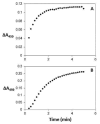Facile synthesis of chlorin bioconjugates by a series of click reactions
- PMID: 28304032
- PMCID: PMC5463999
- DOI: 10.1039/c7cc01265a
Facile synthesis of chlorin bioconjugates by a series of click reactions
Abstract
A multifunctional chlorin platform appended with four short polyethylene glycols and a carboxylate-linker allows rapid conjugation to biotargeting motifs such as proteins and oligonucleotides. The stability and photophysical properties of the chlorin enable development of diagnostics, imaging, molecular tracking, and theranostics.
Figures





Similar articles
-
One-Pot Synthesis of Four Chlorin Derivatives by a Divergent Ylide.J Org Chem. 2018 Jun 15;83(12):6307-6314. doi: 10.1021/acs.joc.8b00169. Epub 2018 May 29. J Org Chem. 2018. PMID: 29775305 Free PMC article.
-
Click chemistry inspired synthesis of glycoporphyrin dendrimers.J Org Chem. 2013 Aug 16;78(16):8184-90. doi: 10.1021/jo4012392. Epub 2013 Aug 5. J Org Chem. 2013. PMID: 23862720
-
Synthesis of β-pyrrolic-modified porphyrins and their incorporation into DNA.Chemistry. 2011 May 23;17(22):6227-38. doi: 10.1002/chem.201003200. Epub 2011 Apr 18. Chemistry. 2011. PMID: 21503985
-
Dual modification of biomolecules.Org Biomol Chem. 2016 Jul 14;14(26):6165-78. doi: 10.1039/c6ob01010e. Epub 2016 Jun 9. Org Biomol Chem. 2016. PMID: 27278999 Review.
-
10 years of click chemistry: synthesis and applications of ferrocene-derived triazoles.Chem Asian J. 2011 Oct 4;6(10):2670-94. doi: 10.1002/asia.201100408. Epub 2011 Aug 31. Chem Asian J. 2011. PMID: 21882351 Review.
Cited by
-
Lanthanide porphyrinoids as molecular theranostics.Chem Soc Rev. 2022 Jul 18;51(14):6177-6209. doi: 10.1039/d2cs00275b. Chem Soc Rev. 2022. PMID: 35792133 Free PMC article. Review.
-
Development and Validation of Nerve-Targeted Bacteriochlorin Sensors.J Am Chem Soc. 2023 Jul 5;145(26):14276-14287. doi: 10.1021/jacs.3c02520. Epub 2023 Jun 20. J Am Chem Soc. 2023. PMID: 37339504 Free PMC article.
-
Chlorophyll-Inspired Red-Region Fluorophores: Building Block Synthesis and Studies in Aqueous Media.Molecules. 2018 Jan 10;23(1):130. doi: 10.3390/molecules23010130. Molecules. 2018. PMID: 29320445 Free PMC article.
-
NaV1.7 targeted fluorescence imaging agents for nerve identification during intraoperative procedures.bioRxiv [Preprint]. 2024 Apr 6:2024.04.06.588368. doi: 10.1101/2024.04.06.588368. bioRxiv. 2024. PMID: 38617358 Free PMC article. Preprint.
-
Bimodal Imaging of Mouse Peripheral Nerves with Chlorin Tracers.Mol Pharm. 2021 Mar 1;18(3):940-951. doi: 10.1021/acs.molpharmaceut.0c00946. Epub 2021 Jan 6. Mol Pharm. 2021. PMID: 33404254 Free PMC article.
References
-
- Dąbrowski JM, Pucelik B, Regiel-Futyra A, Brindell M, Mazuryk O, Kyzioł A, Stochel G, Macyk W, Arnaut LG. Coord Chem Rev. 2016;325:67–101.
-
- Bonnett R, Charlesworth P, Djelal BD, Foley S, McGarvey DJ, Truscott TG. J Chem Soc Perkin Trans 2. 1999:325–328.
-
- Detty MR, Gibson SL, Wagner SJ. J Med Chem. 2004;47:3897–3915. - PubMed
MeSH terms
Substances
Grants and funding
LinkOut - more resources
Full Text Sources
Other Literature Sources

